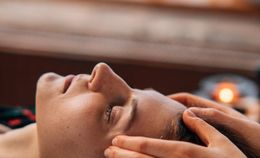Craniosacral therapy has its roots in the 19th century, but the osteopathic physician John Upledger developed the modern techniques used today. In trials with autistic children, he found them to exhibit less self-destructive behavior after undergoing treatment. Through this, he expanded the concept into SomatoEmotional Release therapy and began applying the practice to patients with chronic pain. Using bioelectric measurements to see how patients responded to therapeutic repositioning, he found patients experienced pain relief that extended beyond the session.1
Of course, if you're interested in craniosacral therapy, you'll probably begin by reading online reviews. These reviews will show plenty of anecdotal benefits to patients with a wide range of symptoms. If you look at patient testimonials, you will see it has helped in the treatment of a wide range of problems. From the psychological, such as learning disabilities and anxiety, to the physical, such as neck pain and injuries to the spinal column. Patients recovering from a stroke even report using craniosacral therapy to regain the ability to walk and talk. Some people credit the therapy with curing their TMJ.
It might seem like a lot to expect from something that sounds so simple, but your craniosacral therapist is reading the natural rhythms of and guiding your body along the road to recovery. You can read reviews all day, but until you experience it for yourself you'll never understand the many ways it can benefit you. But what exactly happens during a craniosacral therapy session? And how does it deliver these benefits?
Craniosacral Therapy vs. Massage Therapy
Craniosacral therapy is a gentle, minimally invasive method of facilitating the body's inherent healing process. You might be lying on a massage table, but the two are very different. You should not go into your first session expecting the same kind of care you would from a massage therapist.
The process involves applying gentle pressure and subtle manipulations to the cranium and sacrum to release restrictions and amplify the form and balance of connective tissue around the brain and spinal cord. The therapy is very soothing, but it's shown to have benefits beyond stress reduction. By boosting cerebrospinal fluid circulation, the therapy increases brain health and overall function.
The adjustments are much more minute than the ones applied by a chiropractor. The lack of major force makes the treatment much more relaxing than a chiropractic treatment that, while relieving, can occasionally leave you sore afterwards. It may sound a little bit like myofascial release, and there are some similarities. Myofascial release focuses on stretching out restrictions in the fascial system - the tough connective tissues throughout the body.
Your health and wellness practitioner might employ several or all of these techniques to manage chronic pain. The treatments taken together offer a wonderful synergy that can speed you up on the road to recovery.
The Anatomy of the Craniosacral System
The craniosacral system consists of meningeal membranes and cerebrospinal fluid (CSF) surrounding and protecting the brain and spinal column. It also consists of the structures that attach the membranes and the structures that produce the fluid. When the skull and pelvis are manipulated gently, it can free up tissues and allow the fluid to flow more freely, which cleanses and regenerates the system.
Because all the messages your brain sends your body travel down the spine, the nervous system depends on the craniosacral system to function properly. If the fluid is obstructed from flowing, it can increase pressure on your brain, which will compromise brain function.
When everything is working properly, the flow of the fluid activates receptors to control the flow and signal the production of the CSF. Your therapist can observe the flow, known as your craniosacral rhythm, and help return it to its normal 6 second cycle by applying pressure at the points where these signals are created. By helping your body return to its natural cycle, the functionality of the brain and nervous system are able to return to normal.2
Body-Mind Interplay
More and more, we're seeing the interdependence between physical disorders and mental health, as well as mental disorders and physical health. Chronic pain and depression are closely linked, and there is evidence that there is a physical cause to that depression.3 People with severe mental disorders struggle with many physical ailments, and we are still discovering the nature of these connections.4
With some medical disorders, there is no way to tell whether the problem is physical or mental. There is much we still don't understand about the causes of fibromyalgia, but doctors consider it a combination of physical, psychological, and social disabilities. Craniosacral therapy has shown success in pain treatment or patients suffering from fibromyalgia.5
Similarly, while PTSD is considered a psychological disorder, it can have pronounced physical effects that need to be treated as well. As research becomes more focused on physiological effects of PTSD, we continue to learn about the way the body responds to stress and trauma.6 A practitioner should be aware of these effects, and should incorporate minimally invasive physical treatment as part of their care.7 Craniosacral therapy is a good candidate for this, and physical therapy for patients with PTSD can provide mental and physical benefits.
Your body stores memory
Memory plays a key role in your body, and it's not just in your brain. Your immune system stores information in the T-cells to identify and neutralize pathogens it has encountered before. This information sticks around long after the threat is gone, despite not appearing anywhere in your brain.8
Stem cells also store information to pass on to future generations of cells to better respond to threats in conjunction with the immune system. This can also create problems in people with allergies and chronic inflammatory disorders.9 It is unknown how exactly this process works or if there are other ways the environment might change your body's reactions.
Many physical therapists are mindful of the way the body reacts to its environment and focus on ways to relax areas where stress is manifesting physically. Emotional traumas can manifest as chronic pain, and therapy that focuses on the body should be combined with talk therapy to treat these patients.
How Craniosacral Therapy helps ADD, ADHD
There's no denying the number of prescriptions for ADHD medication has increased dramatically over the last two decades.10 Many people hoping to avoid medication have turned to alternative means to manage their symptoms. By relaxing the parasympathetic nervous system, patients are more calm and can retain focus without medication.
Craniosacral therapists note that patients seeking treatment for ADD & ADHD usually have stress at the base of the skull from strain patterns that can be caused by many common occurrences. By relieving this stress the patients through a series of sessions the patients can resolve the issue naturally and avoid the side effects of prescription drugs.11
Craniosacral Therapy can help with autoimmune disorders
It may surprise you to see that many positive reviews of craniosacral therapy deal are from patients with multiple sclerosis (MS). MS is a disorder in which the immune system targets oligodendrocytes in the nervous system. Thanks to craniosacral therapy, many patients suffering from MS can find relief from the urinary tract symptoms12 associated with it. Because many people with MS have chronic urinary tract infections, they struggle with a frequent, urgent need to urinate. Manual craniosacral therapy on the pelvis reduces the frequency of the urges, and many of the patients say their overall quality of life has been improved as well.
People suffering from asthma and allergies have also found relief from craniosacral therapy. People who suffer from these conditions often limit outdoor activity for fear of triggering their allergies or asthma, and their overall health can be greatly improved when they no longer have to avoid possible triggers.
Reduction in stress prolongs life
Elevated levels of cortisol - often called the "stress hormone:" - weakens the cells throughout your body. Your body ages faster and your longevity is affected the longer you go without stress management.13 You may not suffer from any of the disorders, but stress could still be impacting your life. Stress has a way of permeating your day even, when you take time to relax.
Signs of stress include muscle tension, upset stomach, headaches, irritability, and insomnia. By inducing a state of deep relaxation, craniosacral therapy can offer stress relief even on the first visit. Craniosacral patients suffering from stress have released stored emotions they've buried over the years during treatment. The catharsis from emotional closure they've been unconsciously avoiding is powerful. It is not uncommon for patients to cry as they let go of these emotions, and they leave feeling lighter than they have in years.
The Bottom Line
Reading craniosacral therapy reviews gives you just a hint of the overwhelmingly positive experiences patients have with this powerful alternative therapy. But until you experience it yourself, you probably can't imagine the real impact on your life.Leaving your first craniosacral therapy session, you'll likely feel mildly relaxed to euphoric - and repeated sessions lead to longer-lasting results.
Most patients can expect eight sessions, though some might require more visits. Once you are able to shed the stress from the tension you are carrying, you will realize how much unnecessary discomfort you've been putting up with. Try craniosacral therapy and find out how it can change your life.
References:
1 "Upledger, John E, D.O., O.M.M SomatoEmotional Release. Berkley. North Atlantic Books, 2002"
2"The Anatomy of the Central Nervous System and CranioSacral System" http://www.ashfieldphysio.com.au/cns-anatomy.html
3 "The Link between Depression and Chronic Pain: Neural Mechanisms in the Brain" https://www.ncbi.nlm.nih.gov/pmc/articles/PMC5494581/
4 "Physical illness in patients with severe mental disorders. I. Prevalence, impact of medications and disparities in health care" https://www.ncbi.nlm.nih.gov/pmc/articles/PMC3048500/
5 "A randomized controlled trial investigating the effects of craniosacral therapy on pain and heart rate variability in fibromyalgia patients" https://journals.sagepub.com/doi/abs/10.1177/0269215510375909
6 "The long-term costs of traumatic stress: intertwined physical and psychological consequences" https://www.ncbi.nlm.nih.gov/pmc/articles/PMC2816923/
7 "Physical Health Problems After Single Trauma Exposure: When Stress Takes Root in the Body" http://www.traumacenter.org/products/pdf_files/JAPNA425187.pdf
8 "Immunobiology: The Immune System in Health and Disease. 5th edition." https://www.ncbi.nlm.nih.gov/books/NBK27158/
9 "Memory - New Research Reveals Stem Cell Have Them, Too" https://evolutionnews.org/2018/11/memory-new-research-reveals-cells-have-it-too/
10 "Prescribing trends of attention-deficit hyperactivity disorder (ADHD) medications in UK primary care, 1995-2015" https://www.ncbi.nlm.nih.gov/pmc/articles/PMC5338115/
11 "Helping the Brain Drain: How Craniosacral Therapy Aids ADD/ADHD" https://upledger.ie/latest-news/how-craniosacral-therapy-aids-addadhd-by-john-upledger/
12 "Effect of craniosacral therapy on lower urinary tract signs and symptoms in multiple sclerosis" https://www.sciencedirect.com/science/article/pii/S1744388108001205
13 "Evolution, stress, and longevity" https://www.ncbi.nlm.nih.gov/pmc/articles/PMC1468174/





















